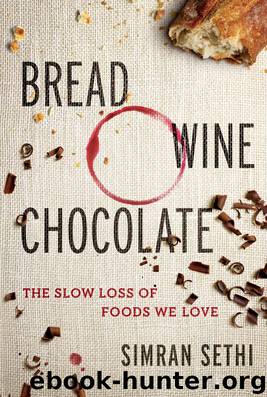Bread, Wine, Chocolate by Simran Sethi

Author:Simran Sethi
Language: eng
Format: epub
Publisher: HarperCollins
Published: 2015-10-04T16:00:00+00:00
III. TASTING COFFEE
Few people love coffee the first time they taste it. We develop an affinity for the drug effect of caffeine, however, forcing ourselves to drink it: Our brain links the flavors to the effects, and we begin to love it, seeing the kaleidoscope of flavors that exist behind the bitterness. We call this an acquired taste.
—PETER GIULIANO
Let your experience of coffee be fluid. Allow Peter’s words to be your guide and open yourself up to flavors that are a bit more subtle. Try to start with inner and outer quietude. As coffee quality expert Silvio Leite said during one of the world’s premier coffee competitions, “Please, silence during the cupping. This is about communication between you and the coffee.”98 This is your chance to hear—and listen.
Preparing for a coffee tasting is a bit more involved than wine or chocolate, but not difficult. One of the critical steps is to buy whole beans and grind them just before sampling. Small hand grinders cost less than $30 and will open up a world of aromas (one that dissipates quickly, which is why it’s a good idea to grind beans close to drinking).
Curate your curiosity. Coffee reflects terroir, post-harvest processes and the skills of those who roast it. Start off trying different regions from a single roaster—or a single place expressed by different roasters. Over time, this will help you develop a baseline for what you love.
Professional cuppers grind beans to the texture of coarse sand, brew them in hot water (around 200 degrees Fahrenheit), skim the grinds off by hand, and then sample the coffee without the distraction of milk or sugar.99 This tea-like preparation is the easiest way to find everything in coffee, including defects.
Take a look at the Counter Culture Coffee defect wheel found on page 347 and see what, if any, terms resonate. Ideally, your coffee should be absent of these qualities.
Although the Counter Culture Coffee Taster’s Flavor Wheel isn’t the industry standard (that designation belongs to the SCAA Flavor Wheel, which was created by the broader coffee community), it beautifully illustrates the range of what’s possible—of positive smells and tastes that will help you identify not only what you love, but what you don’t.
The wheel was largely the brainchild of Counter Culture Coffee’s buyer and quality manager Timothy Hill. He explained in Barista Magazine: “The wheel is design[ed] to be very intuitive and [responsive] . . . as the frequency of descriptions is based on what is popular in coffee at that moment. For instance right now . . . washed Ethiopian coffees are extremely popular and gaining market share among the best roasters in the country. As those coffees tend to be very floral, citric, and fruited, this will likely mean those categories continue to dominate the wheel and potentially even expand. Coffees that are earthy and tobaccoy are losing their popularity . . . so likewise those categories will continue to shrink in size and scope.”100 This is also why the SCAA and World
Download
This site does not store any files on its server. We only index and link to content provided by other sites. Please contact the content providers to delete copyright contents if any and email us, we'll remove relevant links or contents immediately.
Craft Beer for the Homebrewer by Michael Agnew(17929)
Marijuana Grower's Handbook by Ed Rosenthal(3508)
Barkskins by Annie Proulx(3191)
Project Animal Farm: An Accidental Journey into the Secret World of Farming and the Truth About Our Food by Sonia Faruqi(3013)
Red Famine: Stalin's War on Ukraine by Anne Applebaum(2814)
The Plant Messiah by Carlos Magdalena(2745)
0041152001443424520 .pdf by Unknown(2591)
Organic Mushroom Farming and Mycoremediation by Tradd Cotter(2563)
In the Woods by Tana French(2407)
7-14 Days by Noah Waters(2245)
Beer is proof God loves us by Charles W. Bamforth(2245)
The Art of Making Gelato by Morgan Morano(2159)
Meathooked by Marta Zaraska(2143)
Reservoir 13 by Jon McGregor(2141)
Birds, Beasts and Relatives by Gerald Durrell(2132)
Borders by unknow(2115)
The 7 Habits of Highly Effective People: Powerful Lessons in Personal Change (25th Anniversary Edition) by Covey Stephen R(2080)
Between Two Fires by Christopher Buehlman(2030)
The Lean Farm Guide to Growing Vegetables: More In-Depth Lean Techniques for Efficient Organic Production by Ben Hartman(2010)
